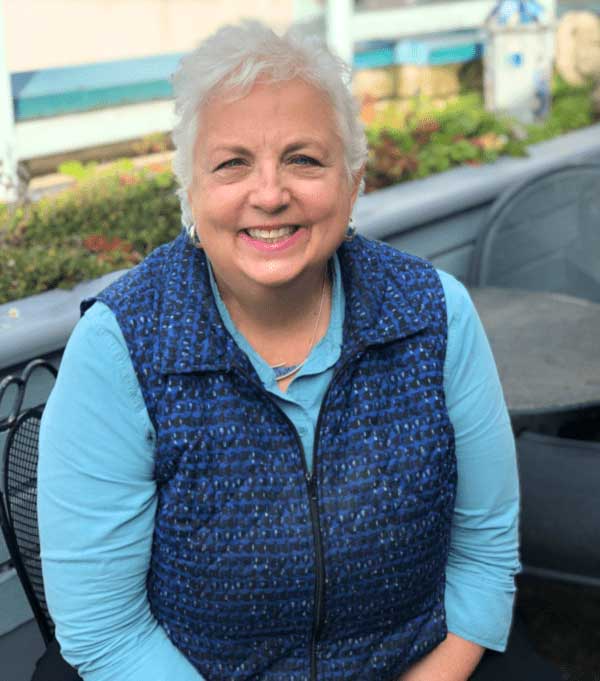First person: A Palliative Response Team counsellor’s story
Most of us who work or volunteer at Victoria Hospice have had this experience: Someone asks about our work, and they wonder how – and why – we can do what we do.
As a counsellor with the Palliative Response Team (PRT), I work alongside a Registered Nurse, with support from a Palliative Care Physician, and visit patients in their homes at the end of life.
We complement what family members and other community resources, like Home and Community Care and family doctors, provide to help people stay at home, as safely and comfortably as possible. We go into situations where there is some kind of crisis of symptoms: escalating pain, shortness of breath, an anxiety attack, or signs of delirium related to end of life.
I’ve come to appreciate that palliative care is a highly specialized area of practice. Our RNs assess a complex array of symptoms, consult with palliative care physicians, and can often immediately address the symptom crisis. By the end of most visits, we see tangible results over the period of a few hours. Family members have been given tools and greater understanding of what is happening, the patient’s symptoms have been addressed, and a plan is in place for on-going care.

Over and over again, we see families rise to the challenges that end-of-life care brings. Family members don’t always get along or magically agree on every decision. People who are dying may be moody, demanding, or uncommunicative. Family members get exhausted and on edge. They don’t – they can’t – do it all perfectly. But generally, we see people at their best, wanting to show their love for one another and wanting to give their person – our patient – the best death they can. It’s inspiring to see what people can do, even in the most challenging circumstances.
When a care provider can give care that makes a difference to the quality of people’s lives, there is an immediate sense of satisfaction, of having made a difference – and the work is meaningful. This is the kind of experience that keeps people working in palliative care.
Here are some examples of situations that have touched me and kept me engaged in the work.
Laughter and tears
A family gathered to be with their mother the weekend prior to her scheduled date for Medical Assistance in Dying (MAID). The grown children scouted locations for wheelchair accessible beaches around Victoria. Other family members bought groceries, reviewed recipes, and prepared their mother’s favourite traditional meal. Although they were sad to be losing their loved one, they were totally engaged in making the family’s time together special. There was laughter and tears as they anticipated what lay ahead.
Honouring with love
When our team arrived at a home to provide a formal pronouncement of death, two young men were washing their father’s body and dressing him to prepare for the arrival of funeral home staff. Family members talked good-naturedly about what kind of shirt Dad should be buried in. The women picked out something dressy; the young men came out of the patient’s room to object. Dad would want one of his comfortable flannel shirts, they said, and made the change. We were struck by how much the young men wanted to honour their father and his unique personality, in every way.
Returning a mother’s care
A wiry, slight man in his 50’s had moved back home to live with his mother to support her as she declined and moved towards death over the past year. For many months, he’d done all the physical care himself, which was challenging for him, given her size and immobility. We got some resources in place to help. He was a rough kind of fellow on the surface, who had experienced many challenges: addictions, financial issues, divorce, and his own poor health. But when I asked how he’d coped with doing his mother’s care on his own, he looked at me directly, tearing up and said: “Well, she did the same for me, didn’t she?”
Gathering in community
We were checking in on a woman who was approaching end of life who had struggled with shortness of breath. She was comfortable that day, finally, lying peacefully in a bed set up in the main living area. As we spoke with her auntie, the main caregiver, other members of her Indigenous community entered the home and sat calmly. With ease, half a dozen people were given coffee and breakfast. Quiet chats took place. Some came to talk softly and hold the woman’s hand. There was a sense of acceptance all around. As we were leaving, an Elder thanked us for the care we had provided to them.
It may sound sentimental, but it makes me want to be a better person when I see what human beings can be for one another. It reminds me that life is not all about war and violence and inhumanity.
Life can be tender, caring, sensitive, collaborative, creative and resourceful. These are the words that come to mind when I think of the patients and families we see in Hospice.
Nancy Payeur, MSW, RSW
Counsellor, Palliative Response Team